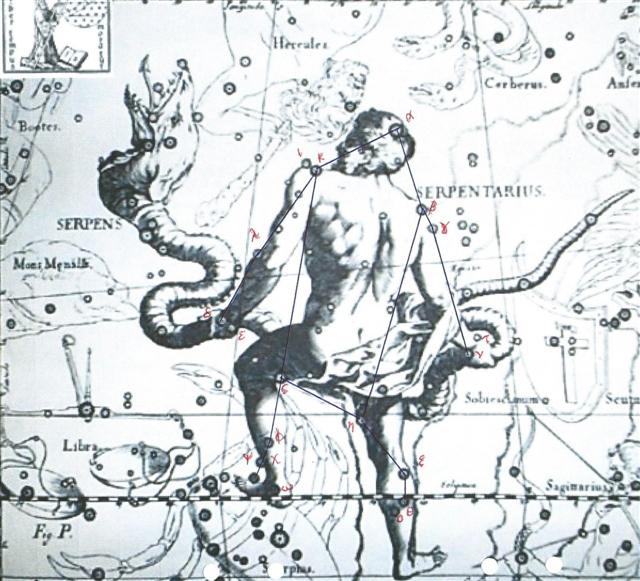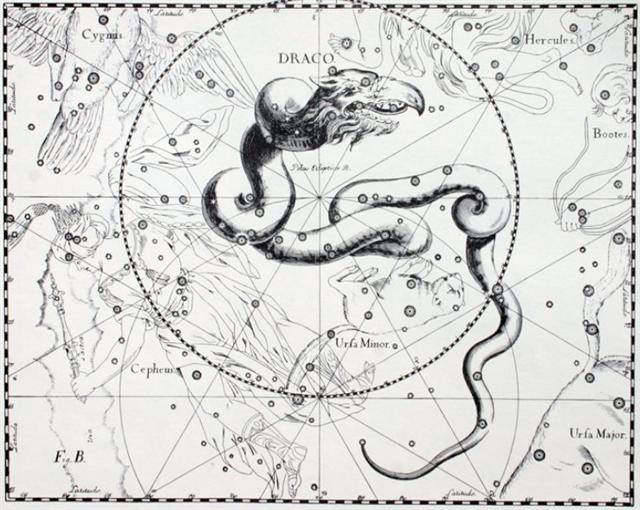Although
Antares
was at
the
SEPTEMBER
equinox
I have
suggested
the star
patterns
were
defined
for the
time of
Haedus
II and
then the
heliacal
stars at
the
●SEPTEMBER
equinox
would
have coincided
with
those
which in
rongorongo
times
rose
with the
Sun 260
days
after
0h:
| ●SEPTEMBER 10 |
11 (254) |
12 |
(4 * 64) |
14 (*177) |
| SEPTEMBER 21 |
EQUINOX |
23 (266) |
24 |
25 (*188) |
 |
 |
 |
 |
 |
| Ga7-15 |
Ga7-16 (185) |
Ga7-17 |
Ga7-18 |
Ga7-19 |
| ρ Ophiuchi (248.1), Kajam (248.3), χ Ophiuchi (248.5), She Low, ι Tr. Austr. (248.7), ζ Tr. Austr. (248.8) |
Al Kalb-16 / Jyeshtha-18
ANA-MUA |
γ Apodis (250.1), σ Herculis (250.3), θ Tr. Austr. (250.6), τ Scorpii (250.7) |
Han (251.0) |
ζ Herculis, η Tr. Austr. (252.1), η Herculis, β Apodis (252.5) |
| ANTARES (249.1), Marfik, φ Ophiuchi (249.5), ω Ophiuchi (249.8) |
| November 24 |
25 (329) |
26 |
27 |
28 |
| 'October 28 (301) |
29 (*222) |
30 |
31 |
'November 1 |
| "October 14 |
15 (*208) |
16 |
17 (290) |
18 |
| ●SEPTEMBER 15 |
16 |
17 (260) |
(9 * 29) |
19 (*182) |
| SEPTEMBER 26 |
27 |
28 (*191) |
29 (272) |
(3 * 91) |
 |
 |
 |
 |
 |
| Ga7-20 |
Ga7-21 (190) |
Ga7-22 |
Ga7-23 |
Ga7-24 |
| Atria (253.9) |
Tail-6 |
ι Ophiuchi (255.3), Grafias (255.4) |
κ Ophiuchi (256.2), ζ Arae (256.5), ε Arae (256.8), Cujam (256.9) |
no star listed (257) |
| Wei, η Arae (254.3), DENEBAKRAB (254.7) |
| November 29 |
30 |
December 1 (335) |
2 (*256) |
3 |
| 'November 2 |
2 |
3 |
4 (*229) |
5 (310) |
| "October 19 |
20 |
21 (*214) |
22 (295) |
23 |
| ●SEPTEMBER 20 |
21 |
EQUINOX |
23 (266) |
24 |
25 (*188) |
| OCTOBER 1 |
2 |
3 |
4 (277) |
5 |
6 (*199) |
 |
 |
 |
 |
 |
 |
| Ga7-25 |
Ga7-26 |
Ga7-27 (196) |
Ga7-28 |
Ga7-29 |
Ga7-30 |
| 17h (258.7) |
Mula-19 |
NODUS I (260.0), π Herculis (260.7), Ras Algethi (260.8) |
Sarin (261.0), ο Ophiuchi (261.4)
Alrisha
|
ξ Ophiuchi (262.2), θ Ophiuchi, ν Serpentis, ζ, ι Apodis (262.4), ι Arae (262.8), ρ Herculis (262.9) |
β, γ Arae (263.3), κ Arae (263.5), σ Ophiuchi (263.6) |
| no star listed (258) |
SABIK (259.7), η SCORPII (259.9) |
| December 4 |
5 |
6 (340) |
7 (*261) |
8 |
9 |
| 'November 6 |
7 |
8 |
9 (314) |
10 |
11 (*236) |
| "October 24 |
25 |
26 |
27 (300) |
28 |
29 (*222) |


At the
●SEPTEMBER
equinox
there was a
'tail
fish' (ika
hiku) at
Nodus
I (ζ
Draconis):
 |
 |
| ika hiku |
Ga7-27 |


This
tail
fish
had
apparently
lost a
leg
compared
to the
one 15 days
earlier
in the
text:
| ●SEPT 7 (250) |
(0h + 9 * 19) |
9 (*172) |
13 |
EQUINOX |
●SEPT 23 (266) |
24 (*187) |
| SEPT 18 (*181) |
(9 * 29) |
20 (263) |
OCT 3 (*196) |
4 (277) |
5 |
 |
 |
 |
 |
 |
 |
| Ga7-12 (181) |
Ga7-13 |
Ga7-14 |
Ga7-27 (196) |
Ga7-28 |
Ga7-29 |
| YED PRIOR |
YED POSTERIOR |
σ SCORPII |
NODUS I |
Alrisha |
LEG OF OPHIUCHUS |
The
name
Nodus
I
refers
to
the
central
curve
of
the
serpentine
body
of
the
Dragon,
above
the
feet
of
upside
down Ursa
Minor.
"δ
...
is
the
Nodus
Secundus
of
several
catalogues,
as
marking
the
2d
of
the
four
Knots,
or
convolutions,
in
the
figure
of
the
Dragon."
(Allen)
From
Nodus
I to
Nodus
II
there
were
227
-
196
= 31
days,
which
ought
to
have
been
known
by
the
rongorongo
writers.
Hanau
in
Ga8-24
was
227
(π)
days
from
the
beginning
of
the
text
and
at
the
time
of
Haedus
II
this
position
would
have
been
216
(= 8
*
27)
days
after
0h:
| ●OCTOBER 21 |
22 (295) |
23 (*216) |
24 |
25 |
| NOVEMBER 1 |
2 |
3 (*227) |
4 (308) |
5 |
 |
 |
 |
 |
 |
| Ga8-22 |
Ga8-23 |
Ga8-24 (227) |
Ga8-25 |
Ga8-26 |
| 19h (289.2) |
Al Baldah-19 |
Aladfar (291.1), NODUS II (291.5), ψ Sagittarii (291.6), θ Lyrae (291.8) |
ω Aquilae (292.1), ρ Sagittarii (292.6), υ Sagittarii (292.7) |
Arkab Prior (293.0), Arkab Posterior, Alrami (293.2), χ Sagittarii (293.6) |
| λ Aquilae (Ant.) (289.1), γ Cor. Austr (289.3), τ Sagittarii (289.4), ι Lyrae (289.5), δ Cor. Austr. (289.8) |
AL BALDAH, Alphekka Meridiana (290.1), β Cor. Austr. (290.2) |
| January 4 |
5 (*290) |
6 |
7 (372) |
8 |
| 'December 8 |
9 |
10 (*264) |
11 (345) |
12 |
| "November 24 |
25 |
26 (*250) |
27 |
28 (332) |

|















